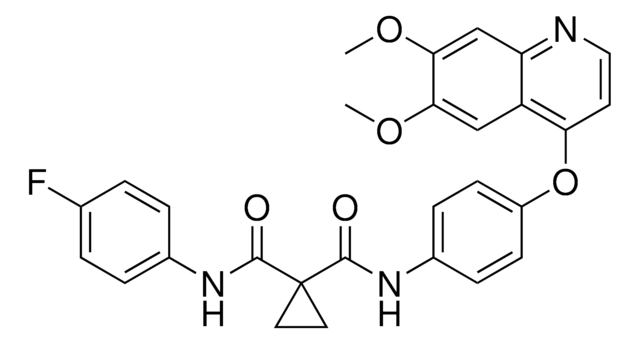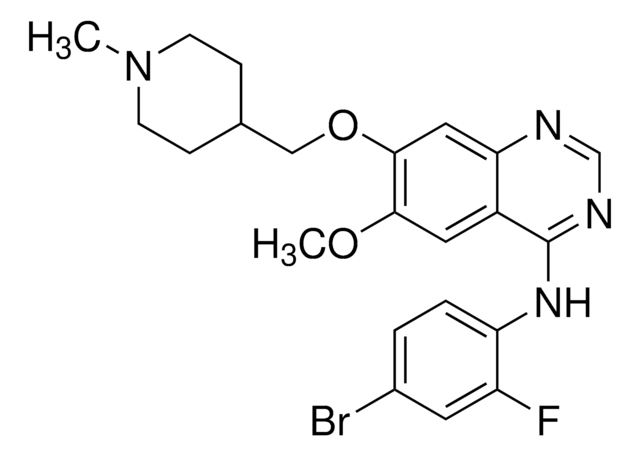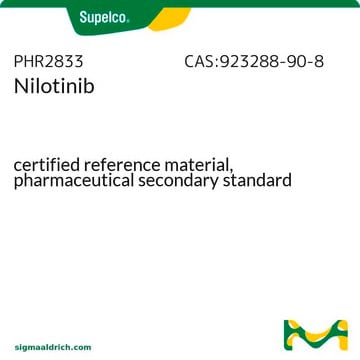SML3915
Cabozantinib malate
≥98% (HPLC)
Synonym(s):
BMS 907351 (S)-malate, BMS-907351 (S)-malate, BMS907351 (S)-malate, Cabozantinib (L)-malate, Cabozantinib (S)-malate, N-(4-(6,7-Dimethoxyquinolin-4-yloxy)phenyl)-N’-(4-fluorophenyl)cyclopropane1,1-dicarboxamide, (2S)-hydroxybutanedioate, N-(4-{[6,7-bis(Methyloxy)quinolin-4-yl]oxy}phenyl)-N′-(4-fluorophenyl)cyclopropane-1,1-dicarboxamide (L)-malate salt, XL 184 (S)-malate, XL-184 (S)-malate, XL184 (S)-malate
About This Item
Recommended Products
Quality Level
Assay
≥98% (HPLC)
form
powder
storage condition
desiccated
color
white to beige
solubility
DMSO: 2 mg/mL, clear
storage temp.
-10 to -25°C
Biochem/physiol Actions
Cabozantinib (XL184; BMS‐907351) is an orally active, potent inhibitor against multiple receptor tyrosine kinases, notably VEGFR2/KDR (IC50 = 35 pM), MET (IC50 = 1.3 nM/wt, 3.8 nM/Y1248H, 11.8 nM/D1246N, 14.6 nM/K1262R), KIT, RET, AXL, TIE2, and FLT3 (IC50 = 4.6, 5.2, 7, 14.3, and 11.3 nM, respectively). Cabozantinib inhibits MET-driven proliferation in cancer cultures (IC50 = 9.9 nM/Hs746T, 19 nM/SNU-5) and simultaneously suppressing metastasis, angiogenesis and tumor growth in vivo (3-100 mg/kg via single or daily p.o. to mice with human MDA-MB-231 xenograft, 1-60 mg/kg via single or daily p.o. to rats with C6 rat glioma).
Caution
Signal Word
Danger
Hazard Statements
Precautionary Statements
Hazard Classifications
Eye Dam. 1 - Repr. 1B - Skin Irrit. 2 - STOT RE 2
Target Organs
Bone marrow,Kidney,Endocrine system,Gastrointestinal tract,Liver
Storage Class Code
6.1C - Combustible acute toxic Cat.3 / toxic compounds or compounds which causing chronic effects
WGK
WGK 3
Certificates of Analysis (COA)
Search for Certificates of Analysis (COA) by entering the products Lot/Batch Number. Lot and Batch Numbers can be found on a product’s label following the words ‘Lot’ or ‘Batch’.
Already Own This Product?
Find documentation for the products that you have recently purchased in the Document Library.
Our team of scientists has experience in all areas of research including Life Science, Material Science, Chemical Synthesis, Chromatography, Analytical and many others.
Contact Technical Service








